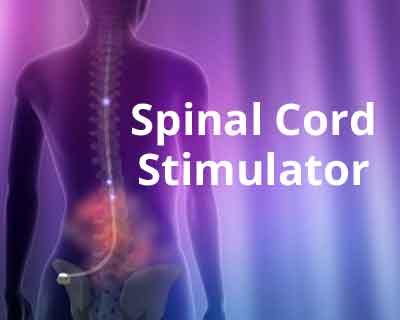- Home
- Editorial
- News
- Practice Guidelines
- Anesthesiology Guidelines
- Cancer Guidelines
- Cardiac Sciences Guidelines
- Critical Care Guidelines
- Dentistry Guidelines
- Dermatology Guidelines
- Diabetes and Endo Guidelines
- Diagnostics Guidelines
- ENT Guidelines
- Featured Practice Guidelines
- Gastroenterology Guidelines
- Geriatrics Guidelines
- Medicine Guidelines
- Nephrology Guidelines
- Neurosciences Guidelines
- Obs and Gynae Guidelines
- Ophthalmology Guidelines
- Orthopaedics Guidelines
- Paediatrics Guidelines
- Psychiatry Guidelines
- Pulmonology Guidelines
- Radiology Guidelines
- Surgery Guidelines
- Urology Guidelines
New Delhi: Spinal cord stimulator cures woman of lumbar spine disc disease

New Delhi : A 35-year-old woman operated twice for lumbar disc disease, was cured of her ailment after the insertion of a spinal cord stimulator through a minimally invasive surgery at a city hospital.
The installation of a spinal cord stimulator, also known as 'pacemaker of the spine' is a rarely used medically procedure due to lack of awareness and expertise in it's insertion.
Himani was in excruciating pain due to her lumbar disc disease even after being injected thrice with spinal injections. The MRI showed a good decompression, but also showed scar formation at the site of the operation.
Though the doctor knew that the insertion of a spinal cord stimulator was the last resort, it took Himani almost ten months to get convinced for surgery.
Explaining the surgical procedure, Aditya Gupta, Director of Neurosurgery at Institute of Neurosciences at Artemis Hospital, said that the patient was initially taken up for a trial lead insertion through a needle. The tip of the trial lead was kept at the D10 vertebra level, and she immediately reported a more than 70 per cent reduction in her pain level.
"Later, she was taken up for a permanent lead and spinal pacemaker insertion through a small incision, and she today enjoys a very good quality of life, needing medications very infrequently, and has been able to start active physiotherapy and go back to normal life and work," Gupta told IANS.
The surgery was performed on August 22 at Artemis Hospital.
"I had once lost hope. However, today due to the doctor's efforts and the spinal stimulator I have been able to get my life back," said Himani.
According to medical sciences 'pacemaker of spine' is an electronic device implanted under the skin and it's electrodes are placed in a spinal cord space called the epidural space.
Electrical impulses are generated with high frequency and few milliamperes of current that blocks the pain signals from travelling through the spinal cord to the brain. This mechanism works over the principle known as "gate control theory of pain".
Talking in detail about the spinal stimulator, Gupta said that the implantation is done in two steps - trial implant and permanent implant.
International Neuromodulation Society states that though the technology was first used in 1967, usage of this advanced technique has been limited to only 14,000 patients across the world every five years.
"It is important to know how well the patient reacts to the stimulation before getting it permanent. A temporary implantation is done which is connected to an external stimulator and is programmed to cover the painful areas and to find out whether this therapy is effective for the level, type, location and the severity of pain."
According to the medical experts, once the surgical wound heals, it is easy to forget the device. The sensations may vary from person to person, but are mostly recorded as a pleasant tingling.

Disclaimer: This site is primarily intended for healthcare professionals. Any content/information on this website does not replace the advice of medical and/or health professionals and should not be construed as medical/diagnostic advice/endorsement or prescription. Use of this site is subject to our terms of use, privacy policy, advertisement policy. © 2020 Minerva Medical Treatment Pvt Ltd